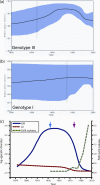Emergence of genotype I of Japanese encephalitis virus as the dominant genotype in Asia
- PMID: 21697481
- PMCID: PMC3196406
- DOI: 10.1128/JVI.00825-11
Emergence of genotype I of Japanese encephalitis virus as the dominant genotype in Asia
Abstract
Japanese encephalitis virus (JEV), a mosquito-borne zoonotic pathogen, is one of the major causes of viral encephalitis worldwide. Previous phylogenetic studies based on the envelope protein indicated that there are four genotypes, and surveillance data suggest that genotype I is gradually replacing genotype III as the dominant strain. Here we report an evolutionary analysis based on 98 full-length genome sequences of JEV, including 67 new samples isolated from humans, pigs, mosquitoes, midges. and bats in affected areas. To investigate the relationships between the genotypes and the significance of genotype I in recent epidemics, we estimated evolutionary rates, ages of common ancestors, and population demographics. Our results indicate that the genotypes diverged in the order IV, III, II, and I and that the genetic diversity of genotype III has decreased rapidly while that of genotype I has increased gradually, consistent with its emergence as the dominant genotype.
Figures



References
Publication types
MeSH terms
Substances
Associated data
- Actions
- Actions
- Actions
- Actions
- Actions
- Actions
- Actions
- Actions
- Actions
- Actions
- Actions
- Actions
- Actions
- Actions
- Actions
- Actions
- Actions
- Actions
- Actions
- Actions
- Actions
- Actions
- Actions
- Actions
- Actions
- Actions
- Actions
- Actions
- Actions
- Actions
- Actions
- Actions
- Actions
- Actions
- Actions
- Actions
- Actions
- Actions
- Actions
- Actions
- Actions
- Actions
- Actions
- Actions
- Actions
- Actions
- Actions
- Actions
- Actions
- Actions
- Actions
- Actions
- Actions
- Actions
- Actions
- Actions
- Actions
- Actions
- Actions
- Actions
- Actions
- Actions
- Actions
- Actions
Grants and funding
LinkOut - more resources
Full Text Sources
Other Literature Sources

